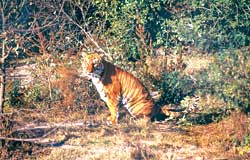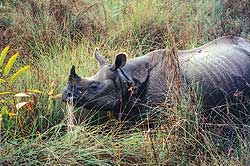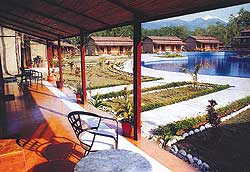 Chitwan used to be the happy hunting grounds of Nepal's royals until it was declared a national park in 1973. Ever since, nature lovers have flocked here from all over the world to do shooting of a different kind: with cameras. A safari on elephant back through the early morning mist, lurching along the floodplain of the Rapti to catch a glimpse of a tiger or a rhino has become an essential part of the Royal Chitwan National Park experience.
Chitwan used to be the happy hunting grounds of Nepal's royals until it was declared a national park in 1973. Ever since, nature lovers have flocked here from all over the world to do shooting of a different kind: with cameras. A safari on elephant back through the early morning mist, lurching along the floodplain of the Rapti to catch a glimpse of a tiger or a rhino has become an essential part of the Royal Chitwan National Park experience.
This is easily Nepal's favourite wildlife destination for nature lovers with an abundance of flora and fauna: 570 species of flowering plants, 40 species of mammals, 486 bird species, 17 reptiles and 68 fish species are among the known inhabitants of the jungle. Chitwan is also a haven for several endangered mammals, including the Royal Bengal Tiger, the Greater One Horn Rhino and the Gangetic Dolphin.  In the old days, even royal visitors made do with tents or machans perched high in the trees. Today, the discerning nature lover need not part with creature comforts. There are world class lodges operating inside the park boundary and several others on the fringes. In the heart of the jungle, wild animals often stroll through the grounds of the lodges, some of them even stopping to nibble at the carefully tended flowerbeds.
In the old days, even royal visitors made do with tents or machans perched high in the trees. Today, the discerning nature lover need not part with creature comforts. There are world class lodges operating inside the park boundary and several others on the fringes. In the heart of the jungle, wild animals often stroll through the grounds of the lodges, some of them even stopping to nibble at the carefully tended flowerbeds.  Whether you stay within the park or outside its perimeters, all visitors are guaranteed elephant safaris, nature walks with a trained naturalist, bird watching excursions, evening slide shows and boating on the river where you may see the rare river dolphin swimming alongside. Spotting Gharials sunning themselves is almost a certainty as are water birds that stilt and stalk the river banks. February is the best time of year to visit. The days are warm and the nights cold enough to
Whether you stay within the park or outside its perimeters, all visitors are guaranteed elephant safaris, nature walks with a trained naturalist, bird watching excursions, evening slide shows and boating on the river where you may see the rare river dolphin swimming alongside. Spotting Gharials sunning themselves is almost a certainty as are water birds that stilt and stalk the river banks. February is the best time of year to visit. The days are warm and the nights cold enough to  ensure the fog burns off quickly at dawn to display the Annapurnas and Himalchuli to the north. With the onset of spring come meadows of wildflowers, and with it, the flutter of butterflies and birds.
ensure the fog burns off quickly at dawn to display the Annapurnas and Himalchuli to the north. With the onset of spring come meadows of wildflowers, and with it, the flutter of butterflies and birds.
Across the deceptively placid current of the Narayani River and a twenty-minute jeep ride later, an opening in the forest reveals Temple Tiger. Naturalist Ambika Parajuli gives you a crash course in wildlife biology: the Greater One Horn Rhino is a 2.5 ton vegetarian, has an average life span of 50 years, two-thirds of which is spent in a water hole.  Temple Tiger staff are eager to show off their latest arrivals-three baby elephants, each fathered by a wild male. Durga Kali, Badri Gaj and their older half-brother Ojasho Prashad are friendly and adorable. They have learned to play the crowds, especially if they spy bananas on their visitors. The baby elephants have each had their nuaran, a special naming ceremony. Some even have a rice feeding ceremony, or pasni after six months, though they continue to feed on their mother's milk until they turn two. They are then trained by two older elephants and an experienced mahout, eventually learning 35 oral commands in Tharu.
Temple Tiger staff are eager to show off their latest arrivals-three baby elephants, each fathered by a wild male. Durga Kali, Badri Gaj and their older half-brother Ojasho Prashad are friendly and adorable. They have learned to play the crowds, especially if they spy bananas on their visitors. The baby elephants have each had their nuaran, a special naming ceremony. Some even have a rice feeding ceremony, or pasni after six months, though they continue to feed on their mother's milk until they turn two. They are then trained by two older elephants and an experienced mahout, eventually learning 35 oral commands in Tharu.  A little further east is the legendary Tiger Tops Jungle Lodge, the first to be built inside the park. Its tree houses and bungalows were built with jungle materials and have been recently refurbished. Solar power lights up the lamp, ceiling fan and heated shower in every room.
A little further east is the legendary Tiger Tops Jungle Lodge, the first to be built inside the park. Its tree houses and bungalows were built with jungle materials and have been recently refurbished. Solar power lights up the lamp, ceiling fan and heated shower in every room.
Also accessible by raft, Island Jungle Resort is north-east of Tiger Tops on a jungle island called Bandarjhola. The scrumptious food will make you forget your mother's cooking, and you can wash it down with made-to-order jungle cocktails at the surprisingly well-stocked Tharu bar. In the floodplains of the Narayani, ox-bow lakes continually transform the geography of this area.
Moving eastwards on the northern most edge of the park, Narayani Safari is situated on a bluff overlooking the Rapti and provides an unparalleled jungle experience with fantastic sunset views.  Its true magic is found in the peaceful coexistence of multiethnic communities. Chitwan is a Nepali melting pot and there are Chettris, Magars, Brahmins and Gurungs who migrated here from the mountains to the north. Narayani is now involved in community development, which is supported by income from eco-tourism.
Its true magic is found in the peaceful coexistence of multiethnic communities. Chitwan is a Nepali melting pot and there are Chettris, Magars, Brahmins and Gurungs who migrated here from the mountains to the north. Narayani is now involved in community development, which is supported by income from eco-tourism.
Many of Nepal's 450 Greater One Horned Rhinoceros wander the central northern area of the park, and Gaida Wildlife Camp is ideally located to observe this majestic mammal. Guests can chose from the luxury lodge or outdoor jungle camp overlooking the Dungre River. Built in a semicircle around the dining area, each of the twin sharing bungalows with attached bath and solar powered shower has a sweeping view of the river and jungle beyond.
At the Gharial conservation project in Kasara you can observe fish-eating crocodiles at close quarters. Their characteristically long thin snout sometimes reaches 20 feet in length, restricting Gharials almost exclusively to hunting for fish, a relief for those who want to take a quick dip in the rivers.
 Then there is Chitwan Jungle Lodge which borrows its aesthetics from traditional Tharu architecture. Mud walled huts with comfortable twin beds and attached bathrooms blend in perfect harmony with the wilderness, isolated from villages. Gaurs, the world's largest wild oxen, have come down to the surrounding lower slopes for the dry months in search of water and greener pastures. These shy creatures return to the densely forested Churia hills in the south once the monsoon sets in. Bird watching is a treat: visitors from all over the world flock here to see the Nepal Red-headed Trojan, Paradise Flycatcher, Bengal Florican and Giant Hornbill among the many resident and migrant bird species regularly sighted. Naturalists Ramesh Pradhan and Janak Chaudhary take guests on fascinating nature walks through the jungle, home to 47 species of orchids that bloom in the wet season.
Then there is Chitwan Jungle Lodge which borrows its aesthetics from traditional Tharu architecture. Mud walled huts with comfortable twin beds and attached bathrooms blend in perfect harmony with the wilderness, isolated from villages. Gaurs, the world's largest wild oxen, have come down to the surrounding lower slopes for the dry months in search of water and greener pastures. These shy creatures return to the densely forested Churia hills in the south once the monsoon sets in. Bird watching is a treat: visitors from all over the world flock here to see the Nepal Red-headed Trojan, Paradise Flycatcher, Bengal Florican and Giant Hornbill among the many resident and migrant bird species regularly sighted. Naturalists Ramesh Pradhan and Janak Chaudhary take guests on fascinating nature walks through the jungle, home to 47 species of orchids that bloom in the wet season.
At the eastern edge of the national park where the sal forest of the Chitwan jungle meets the wide valley of the Rapti River, the world is a wild and splendid place. Nestled between the grassland sweeping north to the Mahabharata range and virgin jungle extending south to the Churia hills is Machan Wildlife Resort. Bungalows crafted in the traditional Tharu design decorated with brilliantly colourful art have upper bunks especially suitable for families with children.
Dawn at Chitwan is a splendid affair, especially seen from a dugout canoe drifting gently on the Rapti River. This is a bird paradise, attracting many rare species like the Large Racquet-tailed Drongo, the Ibis and the Giant Hornbill. From Siberia come the Rhodesial Ducks (chakeba chakebi) who mate for life and are the subject of many Nepali love songs.
A quick paddle over the inviting waters of the Rapti River, just outside the northern border of the park, and visitors seeking budget accommodation will find themselves in Sauraha. A one-horse town two decades ago, Sauraha now teems with over 50 budget hotels. But alas, Sauraha is quiet. At Unique Wild Resort, there isn't a single guest in sight and no one greets the lonely traveller. Kasi Ram and Arjun are in the back, crunching numbers to make ends meet. "We hope things will improve. This is how we survive."


